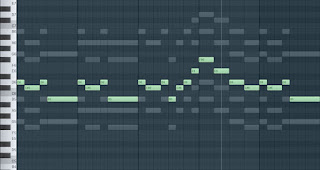After practicing what I have told you thus far, you may have started having ideas for melodies already. While that is amazing, a song lacks all the punch it needs if it is just a melody. In order to give your music the power it needs, you must add harmonies. That's where chords come in!
Chords are, essentially, two or more notes played at the same time, creating a harmony (Hewitt 87). The simplest form of a chord would of course be two notes played at the same time. Even just that can add a lot of depth to your compositions. But chords will be very difficult to understand without first having a basic understanding of intervals.
Whenever the human ear hears music, or any two notes played either one after the other or at the, same time, it automatically analyzes the relationship between them. "This relationship between notes in terms of their pitch--that is, how high or low they are--is called an interval" (Hewitt 63). Intervals exist in two forms. A melodic interval is the different between two notes that occur in succession. A harmonic interval is the difference between two notes that occur at the same time.
The first interval (also called unison or prime) occurs when two of the same note are played. The second, third, fourth, fifth, sixth, and seventh intervals all correspond to the notes location in relation to its scale and previous note. For example, a third interval in the C scale could be C and E, D and F, E and G, and so on. There is also an eighth interval, or octave, which spans from one note to the same note and eighth above.
 |
| (Couldn't rotate the image) |
Finally, there is another type of interval, the compound interval. Compound intervals are any interval that span a distance longer than an octave. An example is a C4 to E5 interval. With that understood, we can move on to chords.
The most commonly used form of a chord, particularly in teaching, is the triad. A triad, obviously, is made up of three notes, and each has a third interval between them, in their root position (will get to that). A C major triad uses the notes C, E, and G.
'Inversions' is a word describing different note placements of a triad. Root position is the inversion in which all notes are a third interval away from each other. First inversion, in C major , would change the note order from C E G, so E G C, creating two thirds and a fourth. Second inversion moves the notes again to G C E, and now there is a third, fourth, and third.
There are many other types of chords, each using different intervals. An example is a seventh chord. This chord is built using a triad, such as C major, and adding the seventh note from the C scale, so that the notes would change to C, E, G, and B. This chord adds a different feeling to your music. Experiment with notes to find chords that work for your music.
Chords and harmony are extremely important in the music I produce. Here are some examples of the power chordal harmonies can add to your music through a song I am working on at the moment.
The main melody of the project:
This is a powerful melody in itself but...
This sounds more powerful. These notes are the melody line doubled under with other notes, creating chords and harmonies which add more depth to the song.
It even gets more powerful if you add a single harmony, such as a bass under the melody.
And you keep adding harmonies to add more and more to the song.
Finally, adding the drums gives it all the 'oomph' you need in your music.
Thank you for reading, and listening! I hope you enjoyed and will use these strategies in your life.
Can you figure out how to make a 9th chord?
| Hewitt, Michael. Music Theory for Computer Musicians. Boston: Course Technology, CENGAGE Learning, 2008. Print. |




0 comments:
Post a Comment